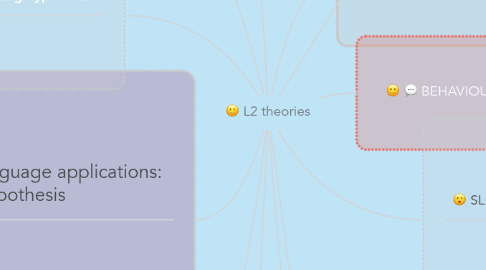
1. The competition model
1.1. • The competition model is closely related to the connectionist perspective
1.1.1. The competition model is proposed as an explanation for both first and second language
1.1.2. acquisition.
1.1.3. Through exposure to thousands of examples of language associated with particular meanings,
1.1.4. learners come to understand how to use the 'cues' with which a language signals specific
1.1.5. functions.
2. Current psychological theories: The cognitivist/ developmental perspective
2.1. Information processing: Norman Segalowitz (2003) and others have suggested that learners have to pay attention
2.1.1. Pay attention' = using cognitive resources to process information.
2.1.1.1. There is a limit to how much information a learner can pay attention to.
3. Connectionism
3.1. Connectionists argue that learners gradually build up their knowledge of language through exposure to the thousands of instances of linguistic features.
4. Second language applications: interacting hypothesis
4.1. conversational interaction is an essential, if not sufficient, condition for SLA.
4.1.1. comprehensible input is necessary for language acquisition. MODIFIED INTERACTION is the necessary mechanism for
4.1.1.1. language acquisition, summarizing the relationship as follows: The interaction hypothesis 1. Interactional modification makes input comprehensible. 3. Therefore, interactional modification promotes acquisition. 2. Comprehensible input promotes acquisition.
4.1.2. making language comprehensible.
5. The noticing hypothesis
5.1. noticing
5.2. hypothesis', suggesting that nothing is learned unless it has
5.2.1. have described techniques, for example, having learners see and hear themselves in videotaped interactions, to explore what they were thinking as they participated in conversations
5.2.1.1. developed crossword puzzles that learners had to solve while speaking aloud. recorded learners in pair work and kept track of the language features they mentioned.
5.3. been noticed.
6. Processability theory
6.1. They analyzed large samples of their speech and described the details of developmental sequences in their production of simple and complex sentences.
6.1.1. development for features of syntax and morphology
7. The sociocultural perspective
7.1. Learning is thought to occur when an individual interacts with an interlocutor within his or her (ZPD).
8. Second language applications: Learning by talking
8.1. • It is cognitive activity and it is social activity.
9. contexts for language learning
9.1. 1. characteristics and the enviroment matter. 2.learning conditions of the learners may differ depending on the learners characteristics,cognitive maturity & metalinguistic awareness.
9.1.1. Learner Characteristics: knowledge of other language scan lead to make incorrect guesses about how the 2nd language works.
10. BEHAVIOURISM
10.1. learning in terms of imitation , practice, reinforcement or feedback on success and habit formation
10.1.1. mimicry & memorization
